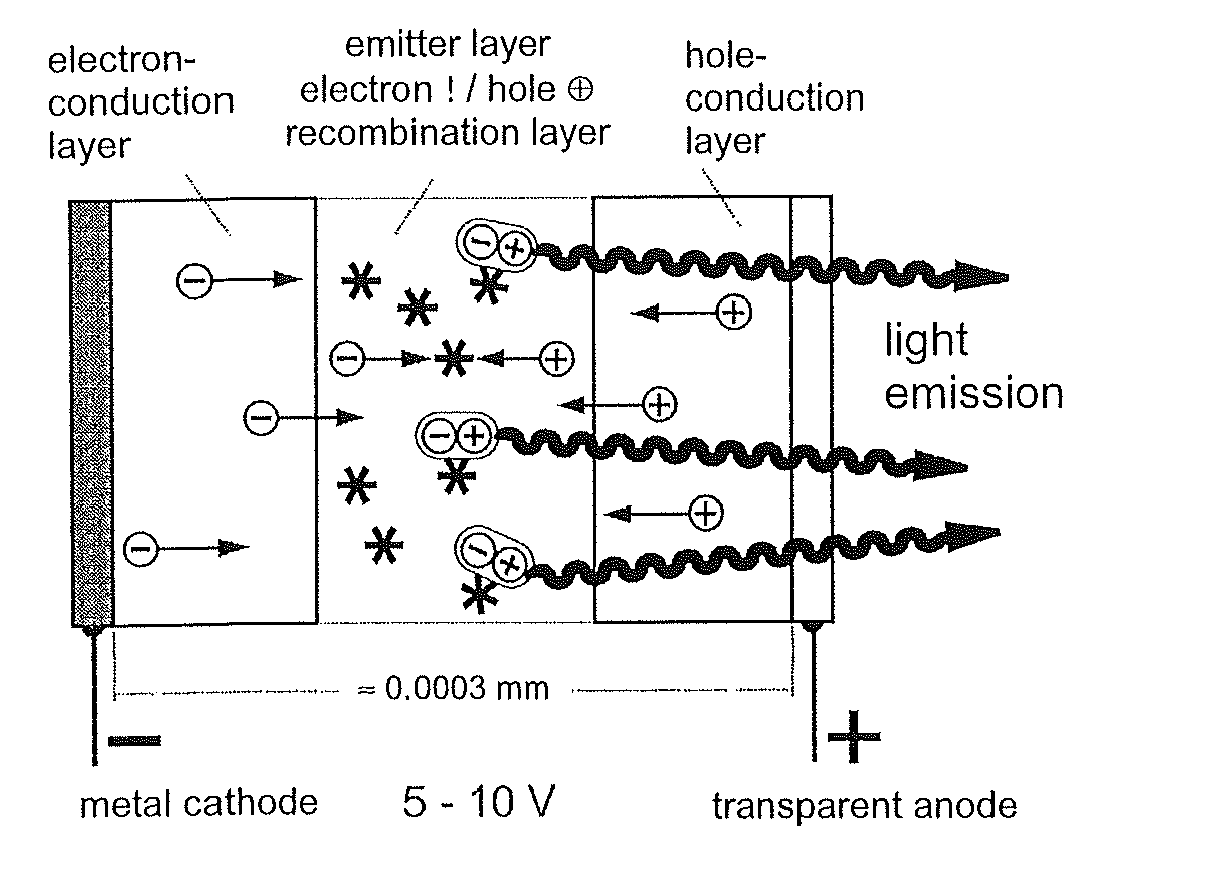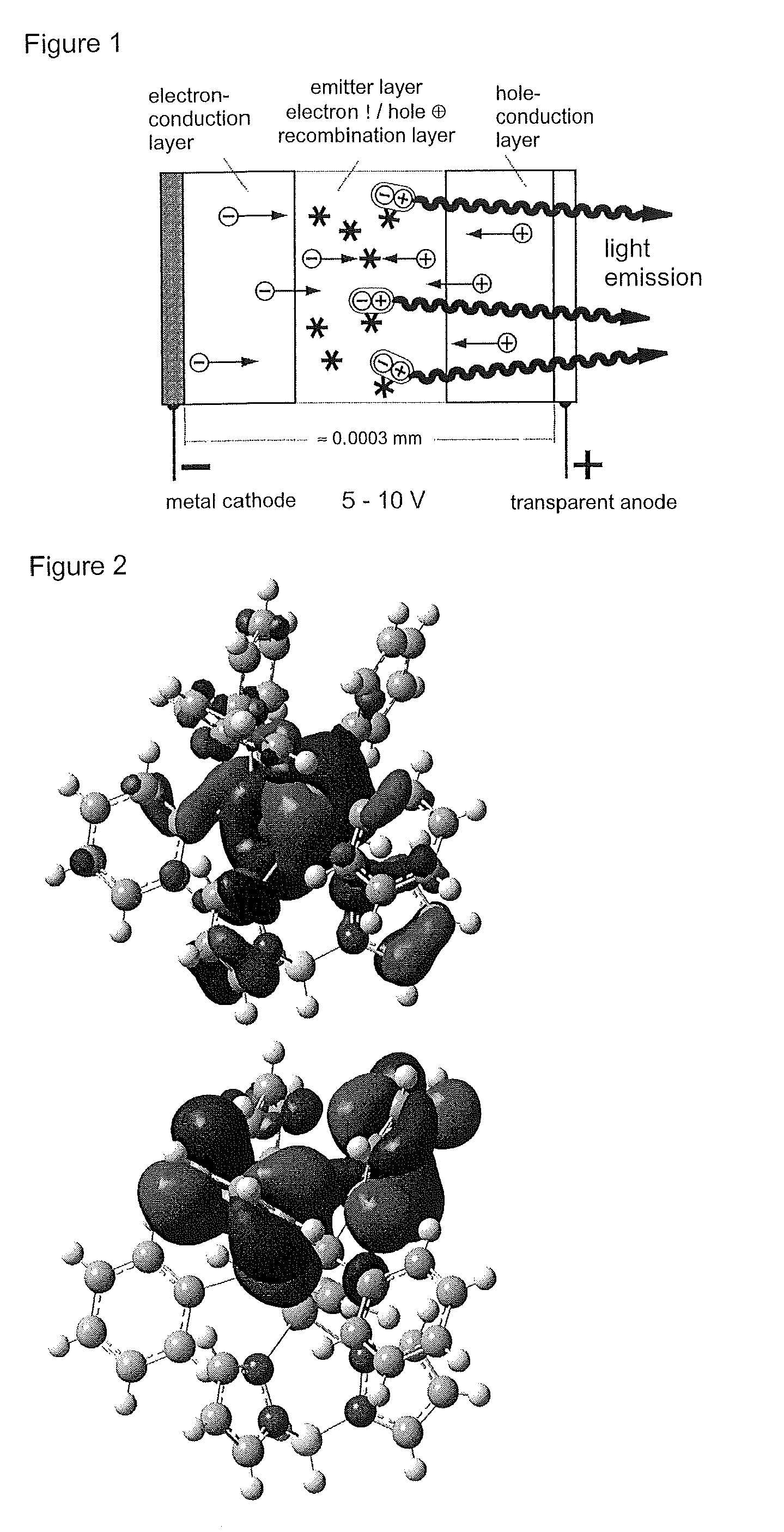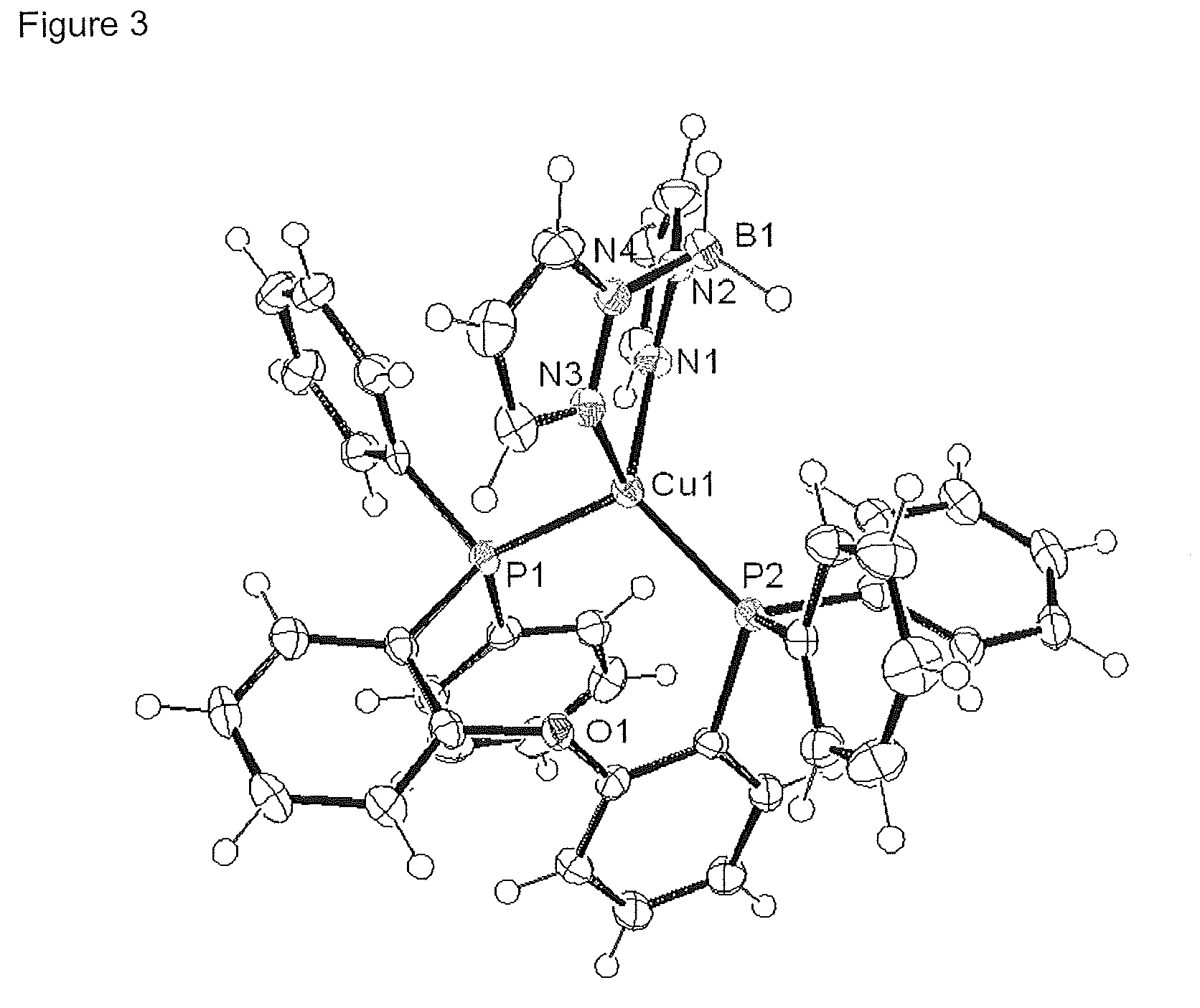Materials for Organic Electroluminescence Devices
a technology of electroluminescence devices and materials, applied in the field of mononuclear, neutral copper (i) complexes, can solve the problems of unachievable colour fidelity, limited number of usable triplet emitters known to date, and difficulty in producing blue-emitting oleds
- Summary
- Abstract
- Description
- Claims
- Application Information
AI Technical Summary
Benefits of technology
Problems solved by technology
Method used
Image
Examples
example 1
[0129]
[0130]Preparation
[0131]A solution of [Cu(CH3CN)4](PF6) (0.186 g, 0.500 mmol) and bis(2-diphenyl-phosphinophenyl)ether (pop, 0.269 g, 0.500 mmol) in acetonitrile (15 ml) is stirred for 30 min. under an argon atmosphere. K[H2Bpz2] (0.093 g, 0.500 mmol) is then added to the solution, and the resultant mixture is stirred for a further 2 hours under an argon atmosphere. The resultant white precipitate is filtered off and washed three times with 5 ml of acetonitrile. Yield 0.313 g, 84%.
[0132]1H-NMR (CDCl3, 298 K): δ 7.59 (d, 2H), 7.05-7.22 (m, br, 20H), 6.78-6.87 (m, br, 6H), 6.68-6.71 (m, br, 2H), 5.84 (t, 2H), 5.30 (s, 2H). 13C{1H}-NMR: δ 128.2, 129.2, 130.6, 132.8, 134.0, 134.3, 140.1. 31P{1H}-NMR: δ−17.23 (s), −18.75 (s). ES-MS: m / e=749.3 (MH+, 100.0%), 750.3 (58.0%), 748.2 (24.0%), 752.3 (21.5%), 753.3 (4.8%). EA: found C, 61.72; H, 4.52; N, 6.72%; calc. C, 61.93; H, 4.59; N, 6.72 (for C43H38BCuN4OP2Cl2).
[0133]Crystal Structure
[0134]An ORTEP image of this complex is shown in FI...
example 2
[0137]
[0138]Preparation
[0139]The synthetic route is analogous to [Cu(H2Bpz2)(pop)] (Example 1). Yield 81%.1H-NMR (CDCl3, 298 K): δ 7.52 (d, 2H), 7.35-7.29 (m, br, 10H), 7.22 (d, 4H), 7.12 (t, 8H), 6.99 (td, 2H), 6.86 (td, 2H), 6.72-6.67 (m, br, 2H), 6.61-6.58 (m, 2H), 5.76 (d, 2H), 1.46 (s, 6H). 13C{1H}-NMR: δ 14.07, 103.1, 119.6, 124.1, 128.1, 128.2, 129.2, 130.4, 132.5, 132.6, 133.8, 133.4, 134.5, 134.7, 135.4, 148.9, 157.0. 31P{1H}-NMR: δ 14.89 (s), −16.18 (s), −17.14 (s). ES-MS: m / e=MH+, 772.2 (100.0%), 778.2 (57.0%), 780.2 (22.2%), 781.2 (6.8%). EA: found C, 68.45; H, 5.10; N, 7.33%; calc. C, 68.00; H, 5.19; N, 7.21 (for C49H43BCuN8OP2Cl2).
[0140]Crystal Structure
[0141]An ORTEP image of this complex is shown in FIG. 5.
[0142]Photoluminescence Properties
[0143]The photoluminescence properties of this complex are shown in FIG. 6.
example 3
[0144]
[0145]Preparation
[0146]The synthetic route is analogous to [Cu(H2Bpz2)(pop)] (Example 1). Yield 79%. 1H-NMR (CDCl3, 298 K): δ 7.38 (br, 4H), 7.05-7.24 (m, br, 20H), 6.76-6.98 (m, br, 6H), 6.68-6.71 (m, br, 2H), 5.85 (t, 4H), 5.30 (s, 4H). 13C{1H}-NMR: δ 104.4, 106.3, 120.3, 124.4, 124.8, 126.4, 128.2, 128.3, 128.5, 128.6, 129.3, 129.7, 130.8, 131.5, 131.6, 131.8, 132.0, 133.2, 133.3, 133.4, 133.8, 134.0, 134.1, 135.3, 135.9, 141.7, 157.8, 157.9, 158.1. 31P{1H}-NMR: δ−14.37 (s). ES-MS: m / e=881.4 (MH+, 100.0%), 882.4 (63.0%), 883.4 (59.0%), 884.3 (26.1%), 880.4 (23.2%), 885.4 (6.3%), 886.3 (1.4%). EA: found C, 61.55; H, 4.48; N, 11.63%; calc. C, 60.85; H, 4.48; N, 11.59 (for C49H43BCuN8OP2Cl2).
[0147]Crystal Structure
[0148]An ORTEP image of this complex is shown in FIG. 7.
[0149]Photoluminescence Properties
[0150]The photoluminescence spectrum of this complex is shown in FIG. 5.
PUM
| Property | Measurement | Unit |
|---|---|---|
| thickness | aaaaa | aaaaa |
| voltage | aaaaa | aaaaa |
| pressure | aaaaa | aaaaa |
Abstract
Description
Claims
Application Information
 Login to View More
Login to View More - R&D
- Intellectual Property
- Life Sciences
- Materials
- Tech Scout
- Unparalleled Data Quality
- Higher Quality Content
- 60% Fewer Hallucinations
Browse by: Latest US Patents, China's latest patents, Technical Efficacy Thesaurus, Application Domain, Technology Topic, Popular Technical Reports.
© 2025 PatSnap. All rights reserved.Legal|Privacy policy|Modern Slavery Act Transparency Statement|Sitemap|About US| Contact US: help@patsnap.com



